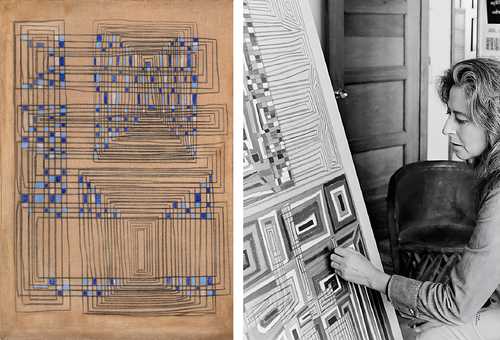Upon arriving in Mexico in 1960, the Romanian-born artist Myra Landau (1926-2018) changed figuration for geometricism; However, in this country said movement never took it into account. Maybe because he cultivated the geometrismo sensible
which refers to a form of geometric abstraction that moves away from the hard line and rigorous compass, often related to the rational.
Responsive geometry is the exhibition of 240 pieces organized by the University Museum of Contemporary Art (MUAC) that aims to recover and visualize
Landau’s work in the context of this Mexican movement, but also in that of artists in Latin America who were looking for other paths towards abstraction. The speaker arrived in Mexico from Brazil, a country where her family took refuge to escape Nazism.
Even in Mexico, Landau maintained dialogues
with “these optical vibrations that were very popular in Brazil in the 60s and 70s. Also with the art of indigenous peoples. At some point perhaps there is a parallel with the geometry of Margarita Azurdía, in Guatemala, who is much more orthodox
says Pilar García, curator of the exhibition of paintings, drawings, tapestry and artist books. Since 1987, an exhibition of his work has not been presented in Mexico City, on that occasion, at the Museum of Modern Art.
The title of this first exhibition monographic retrospective
refers to the notion used by the Brazilian critic Roberto Pontual in the collective sensitive geometry (1978), which opts for gestural lines and a freer character, in contrast to pure abstraction and cold strokes.
–Was Landau the only person to cultivate this form of expression in Mexico?
–Vicente Rojo –García responds–. Many times his work was not so orthodox because suddenly there were geometric figures within abstract paintings.
“Red is included in geometricism, but Landau is not. in the book Mexican geometry (1977), the only woman that Jorge Alberto Manrique mentions is Helen Escobedo.”
At the time, however, Landau was highly recognized by critics Paul Westheim, Jorge Juan Crespo de la Serna, Antonio Rodríguez, Juan Acha, Rita Eder and Manrique himself.
He ventured into engraving
Landau is spoken of as pioneer by introducing (in Mexico) a new materiality and appreciation of engraving
. In Brazil, García notes, “Myra made figuration, landscapes that have to do with churches and Brazilian types. Upon arriving in Mexico he left figuration completely and dedicated himself to experimenting with engraving. He had taken classes with Osvaldo Goeldi, a prominent engraver in Brazil, a fact that made him experiment.
In 1963 he held an exhibition at the Juan Martín gallery in which he exhibited engravings, but instead of showing the printed result, he exhibited the plates as if they were almost sculptural or three-dimensional. He worked a plate with different acids to obtain different colors, also polishing some parts and filing others. He later abandoned this technique because the acids were very harmful. At the time it was an exhibition never seen before in Mexico, using the plate as an engraving and not the paper.
Perhaps what he is most remembered for is his way of using the back of linen; that is, the rough, unprepared part, on which he draws with pastel colors, which produces texture. Its lines of interlocking concentric rectangles, drawn freehand, are reminiscent of traditional textiles. Rhythms It was his most emblematic series.
Landau lived more than three decades in Mexico, from 1960 to 1974, in the capital, and from 1974 to 1994 in Xalapa. The Universidad Veracruzana (UV) invited her to be a professor at the Faculty of Fine Arts.
In 1975, when she founded the Institute of Aesthetic Research and Plastic Creation of the UV, she joined as a researcher. After retiring he moved to Rome, where his daughter lived; then, in 2012, he moved to Jerusalem. Four years later he moved to Alkmaar, Netherlands, where his daughter then lived, until his death.
The artist’s geometric abstraction changed depending on where she was, García says.
Myra Landau: Sensitive geometry It will remain until February 23, 2025 at the MUAC (University Cultural Center, Insurgentes Sur 3000).
